Caravan Evolution
History
The Mooney Caravan's roots originate in a message posted on February 21, 1998 to a Mooney email list started by Doug Fields. The “list” had functioned for the previous couple of years as an information exchange for over 600 Mooney owners and pilots. Following is the text of the message from Akmal Khan (who flew a 252 and enjoyed taking goodhearted jabs at his normally aspirated brethren!):I am taking my family over to Oshkosh this year. I know a number of you Northwest Mooniacs were planning on flying over this year. I thought it might be fun to organize a caravan of Mooneys to fly in together. I will have my speed brakes on so you can keep up :-). I will even fly below 12,500 to accommodate those of you who are oxygen challenged. We could arrange for a couple of stops along the way and maybe do a formation flight into Oshkosh. What do you think?
Through the efforts of a core group of volunteers from the email list led by Jonathan Paul, the first Mooney Caravan of 42 aircraft took off from Madison Dane County Regional airport on July 27, 1998 with Jonathan as lead and Dave Piehler as tail. During the months prior to the flight, the Caravan logistics were worked out by the organizers including a Letter of Agreement with the FAA and the flight procedures, which were developed following consultation with Wayne Collins, who had been leading Bonanzas to Oshkosh since 1990 when he recognized that the only way to camp together in the North 40 was to arrive together!
The Mooney Caravan was patterned after Bonanzas to Oshkosh or B2OSH, except for one significant difference – the Bonanzas flew in 3-ship elements. Jonathan recalls a comment by his friend and fellow Mooney owner Gaylon McSmith , a former F-104 pilot who had flown hundreds of Vietnam missions, that flying in trail was the most difficult way to execute a mass flight, since there are very few visual cues to help the following pilot judge his distance from the plane ahead. Acknowledging this challenge, Caravan organizers felt that the B2OSH format was too ambitious for a first flight. Instead, an in-trail format was selected which was modified in 1999 to a series of 10 plane groups consisting of staggered pairs. This staggered pair format has been utilized for all subsequent Caravan flights up to 2011 (in 2003, the group sizes were reduced to 6 aircraft with a maximum of 42 in the Caravan). It is interesting to note that the B2OSH flight began as an in-trail affair also but quickly evolved to the current 3-ship format to enhance safety.
Evolution of the Caravan Flight
Safety has always been the underlying goal of the Caravan. Given the single ATC clearance for the flight and the sterilized airspace at OSH upon the flights' arrival (the Fisk arrival is put on hold), coupled with the sense of organization and order in the planning of each year's flight, it is generally felt that flying the Caravan is the safest way to arrive at Oshkosh for AirVenture. Yet, over the years, there have been concerns - especially related to relative aircraft spacing. There have been groups losing sight of or encroaching on the group ahead, aircraft within groups have flown out of position during the flight and often, aircraft became bunched up on the final approach to OSH. Post-flight analysis of the issues usually involved the realization that the basic rules of being a wingman hadn't always been followed. Other than an engine failure on departure (with a safe return to MSN) in 1998, there has never been a serious incident or injury on any Mooney Caravan and over 650 aircraft have participated in the flight.In recent years, participation in the flight has slowly declined from a peak of 97 in 2000 to 37 in 2009. The economic recession probably had an impact as well as potential volunteer fatigue among the small but dedicated group of organizers. After the 2009 flight where relative spacing issues occurred as in the past, the Caravan organizers grappled once again with the notion of tweaking the inter-plane and inter-group spacing so as to improve the safety and enjoyment of the flight. Ultimately, a committee was struck to examine whether the safety of the Caravan could be improved by changing the format to something like the B2OSH model (which was also adopted by the Cessnas to Oshkosh group upon their inaugural flight in 2006). Long time Caravaner's expressed concern that participation could drop drastically with a change in format. Nevertheless, the Committee persisted with their mandate and a dialogue was soon initiated with Larry Gaines who has led the B2OSH organization since 2007. Larry enthusiastically offered support including access to training materials as well as to the network of B2OSH training clinics which occur every year in the months prior to AirVenture.
As mentioned, when the notion of a formation style format had been discussed in the past, reluctance to move in this direction was based on the fear that Caravan participation would fall, particularly if the requirement to demonstrate formation flight proficiency was imposed upon participants. The Committee considered this but in discussion with members of the B2OSH and C2OSH organizations, realized that participation might fall initially, but was more likely to rise thereafter once the community recognized the potential for improvement in safety of the flight as well as an increase in the fun factor. Consequently, a recommendation was brought back to Caravan management that the formation concept be tested in a hybrid flight for 2010 where the first portion of the flight would be led by a number of 3 ship elements whose pilots had completed the requisite training and the remainder of the flight would be of the conventional format. This proposal was accepted and several Caravan candidates set out to gain the necessary training.
"Caravan 2010 Cancelled! – “Sploshkosh”
With a hybrid flight plan in place and several pilots prepared to participate in 3-ship elements, Caravan organizers were disappointed when, due to extraordinarily wet conditions at Wittman field, (who can forget Sploshkosh?!) all of the mass arrivals were cancelled virtually at the last minute. Two days of record rains prior to flight day had left Wittman field underwater and everything other than hard surfaces remained closed until well after the opening of AirVenture. Unfazed, one 3-ship element departed from Madison led by James Oliphant (Caravan Apparel coordinator since 1998!) with Larry Brennan on his left wing and my family and I on his right. In the vicinity of the entry point to the Fisk arrival, we broke off and flew the quietest Fisk arrival into Oshkosh I've ever seen. Our arrival with OSH ATC was pre-arranged as we had reserved hard surface parking and a hotel offsite (no camping with the 4 of us on board!). The remaining 2-ship element continued to Appleton and we all reconvened at Friar Tucks to debrief the flight later that afternoon.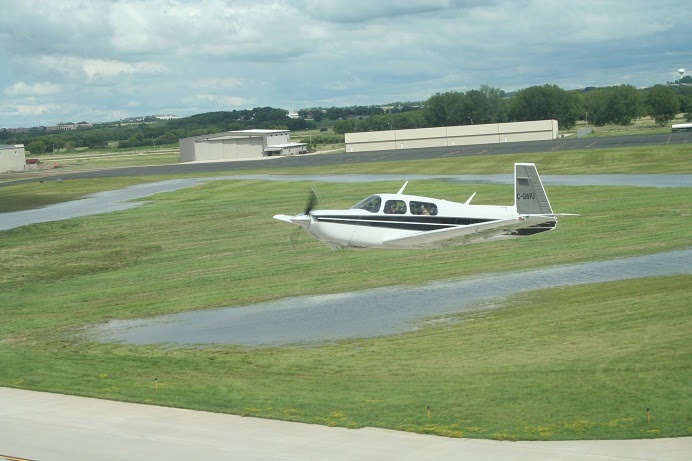
After Oshkosh 2010 and throughout the early part of 2011, the number of formation qualified registrants grew. Most gained their experience by participating in B2OSH clinics. We joined the Bremerton, WA clinic in late June 2011 and with one other Mooney from Vancouver, were warmly welcomed and immediately made part of their community. The training was absolutely outstanding and the experience was exceptional. The watershed realization for us was that it was so much easier being 50 feet away from another plane as compared to 500 or 1500 feet away. In fact, every other formation trained pilot whom I have spoken to has expressed the same conclusion. With basic training in the principles of station-keeping (no overlap, wingman never passes lead, establish and constantly reference a sightline on lead, utilize very small control inputs), the learning was quick and in very short order we were doing 2-ship formation take-offs, executing a series of turns and returning to a formation landing after 30 – 40 minute sorties with relative ease – and a ton of fun! In one weekend, with a little classroom time and a half dozen sorties followed by thorough debriefs of every flight (SOP for formation flying!), we were comfortable and qualified to fly in simple formation manoeuvres – most of which are beyond the requirements for the Caravan flight.
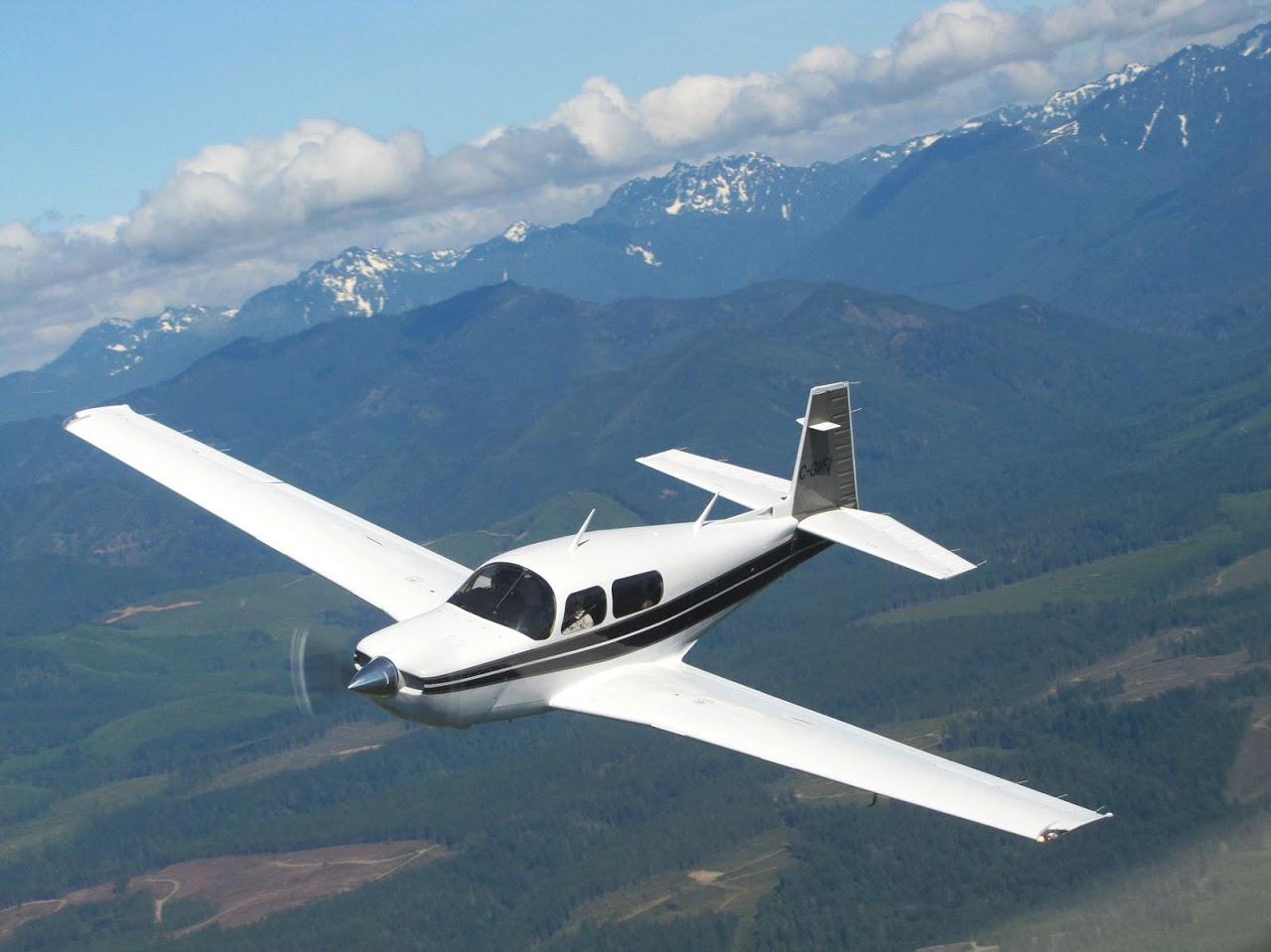
Caravan 2011 – Hybrid Flight
In preparation for our Caravan flight from Madison in 2011, several pilots arrived a couple of days early. This afforded an opportunity to hone our skills, have some more fun and expose other Caravan pilots to what we had learned. Dave Piehler became one of the newly converted in short order and expressed to the others at dinner that evening how fun and relatively easy it was – I believe Dave was the one who coined the term “formation evangelist” to describe his enthusiasm! Our final flight the day before the Caravan was a 4-ship excursion flown with a view to obtaining photos of a Mooney 3-ship for training purposes.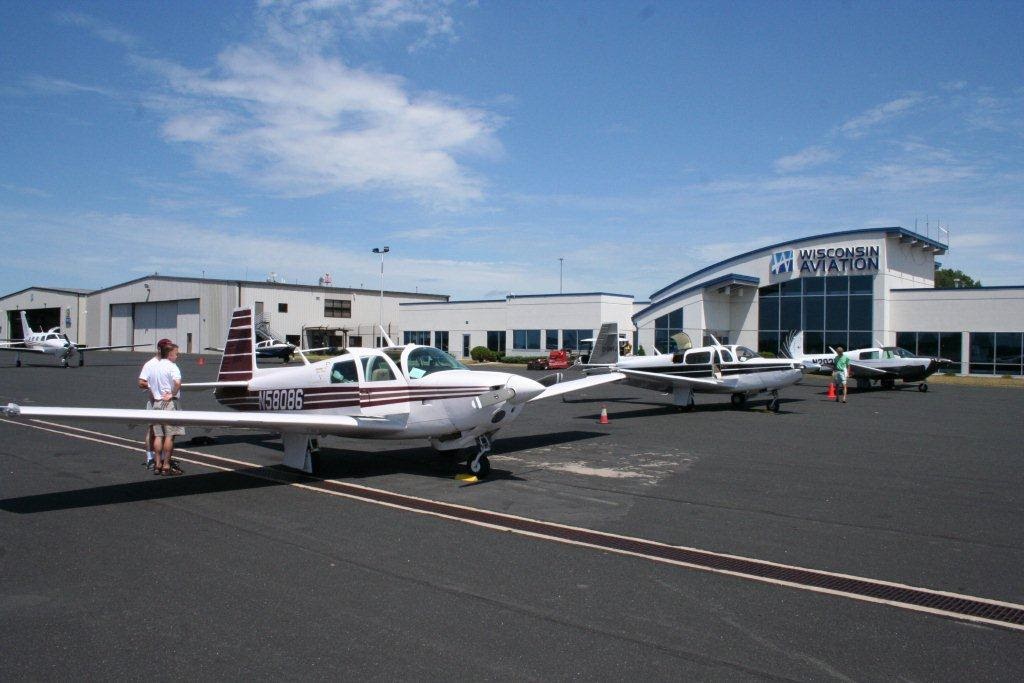
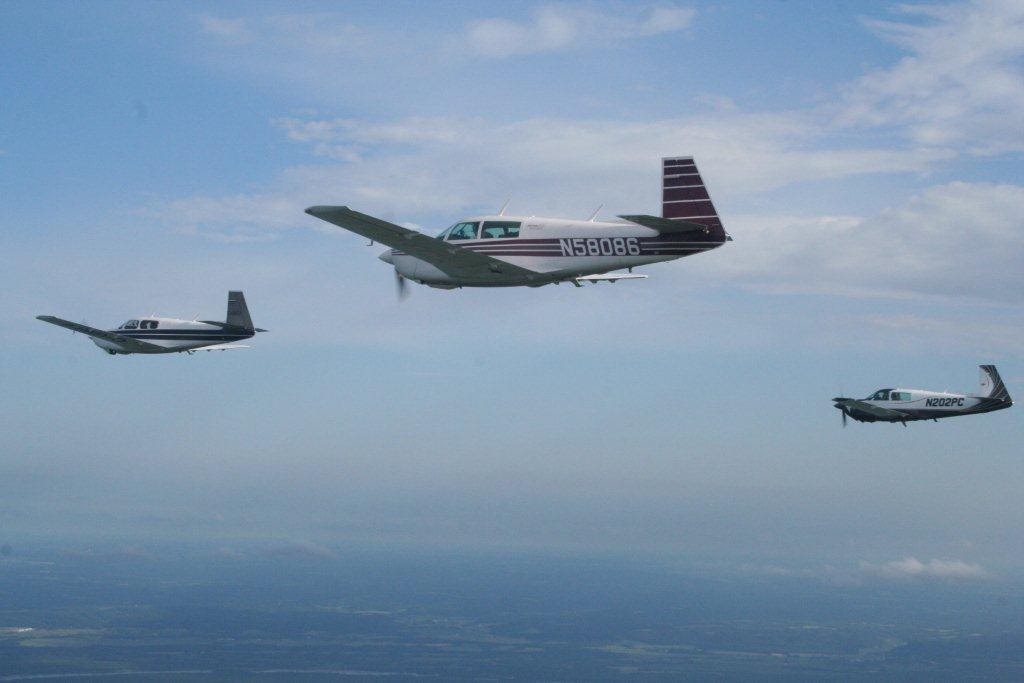
By mid-day on July 23, 2011, we had three 3-ship elements put together and the remainder of the flight organized in three conventional Caravan 6–ship staggered-pair cells plus Mooney tail for a total of 28 aircraft. With pre-flight briefings complete and all aircraft ready for our mission, Mooney lead Rob Higgins, looking at the weather and recognizing worsening conditions, decided to move up our take-off by 30 minutes which was approved by OSH ATC. Rob made the right call. We avoided shifting, stronger winds that confronted later-landing aircraft (and that the whole Caravan would have encountered had he not made the decision). Mooney lead took off at 1505 hours and touched down after an uneventful flight exactly 30 minutes later. It was unofficially reported by OSH ATC that all 28 Mooneys landed in under 7 minutes allowing the Fisk arrival to re-open very quickly.
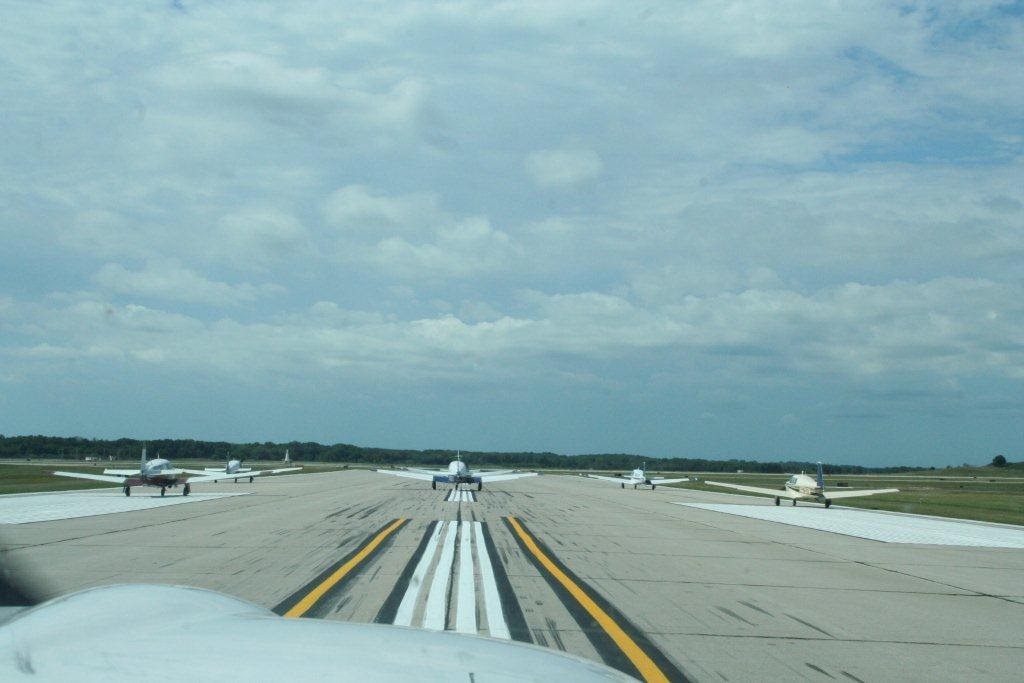
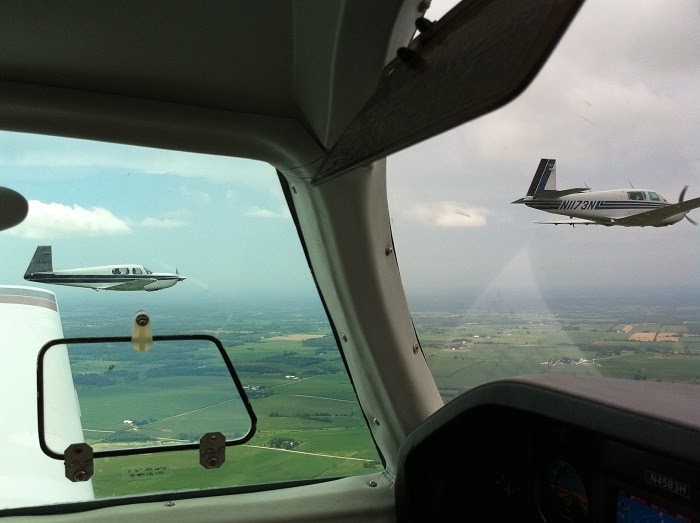
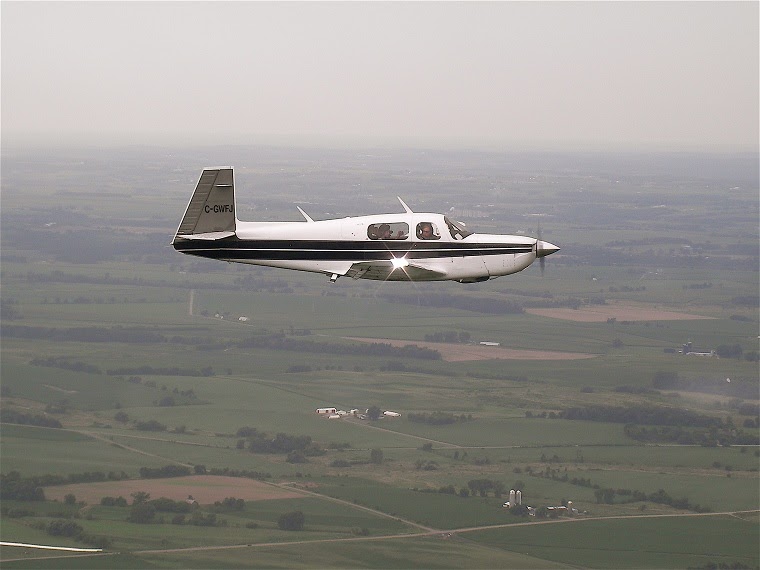
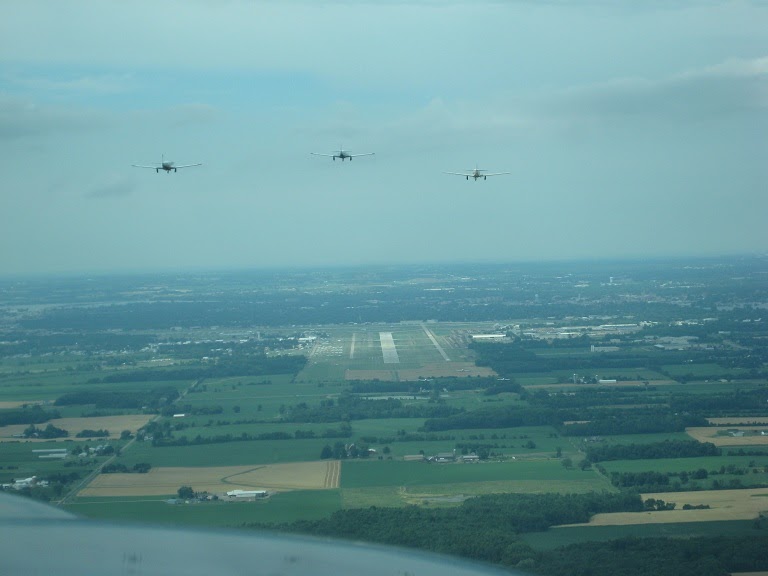
Our first order of business once the aircraft were secured was to conduct our post-flight briefing. This is a mandatory part of formation flying and everyone has their say as to what went well and what could be improved. Those flying the standard Caravan format were included to afford an opportunity to learn from our experience. Enthusiasm permeated the group after the successful flight. The following day, the Caravan Board held a meeting in the North 40 where it was agreed that from that point onward, the Caravan would be flown in full formation format. Several new members, all with formation experience, were appointed to the Board and planning for 2012 was initiated there and then.
Caravan 2012 – Full Formation
Based on our registration list, over 30 pilots had demonstrated formation flight proficiency at various clinics across the country. On Thursday July 19, several aircraft arrived in MSN including most of the Caravan organizers. On Friday July 20, Caravan Flight Operations Director Dave Marten conducted a mini-clinic and following this, several 3-ship practice flights were performed. By Saturday July 21, 25 aircraft had arrived in MSN. A simulated Caravan flight was put up including the full Alpha group 3-ship plus the element leads of all other groups. A simulated Caravan sortie was flown to test route spacing and previous element sight pictures for the lead pilots. Additionally, some concepts were tested to monitor and adjust element spacing in flight and these were used effectively later during the actual Caravan flight.At the allotted time, the full group briefing was held. OSH ATC advised that 36 L & R were in use and anticipated for our arrival. Once complete, the group photo was taken, final checks were made and pilots and passengers boarded for this historic Caravan flight.
Startup, taxi and takeoff all went without a hitch and soon our flight was off MSN on the way to OSH. The spacing methods practiced in the morning were utilized during the flight and resulted in the maintenance of very good spacing throughout the flight right to landing on 36 L & R at OSH. Actual recovery time of the group into OSH was under 5 minutes according to OSH ATC - which is very efficient.
Caravan 2014
As of early February 2014, our 12 person volunteer Board is active with several sub-committees including additional volunteers preparing for this year's flight on Sunday July 27, 2014. This change in date and time (from Saturday afternoon) is new for 2014 and is intended to move the pre-Caravan flight activities closer to the opening of AirVenture to allow more efficient vacation scheduling for participants.The Caravan 2014 flight will consist of 3-ship elements within flights up to 12 aircraft in size. The flights will be separated slightly more than the inter-element spacing to absorb and correct for compression and expansion effects as the flight progresses from MSN to OSH. In order to participate in the Caravan flight, pilots will be required to demonstrate formation flight proficiency either by prior clinic attendance (strongly recommended) or during limited opportunities in Madison in the days prior to the flight. Registration for Caravan 2014 is open as of early-March and upon registration, each registrant will be contacted by a member of our Flight Operations Committee. By prior arrangement, most B2OSH clinics are open to Mooney pilots (see http://www.b2osh.org) and several will include a designated “Mooney Host” from our Caravan team. In addition, our third annual Mooney Caravan clinic is planned for Yuma, AZ (KNYL) from March 28/14 to March 30/14.
I would like to take this opportunity to welcome all past Caravan participants to return and to invite all Mooney pilots considering a trip to AirVenture this year to join us in Madison this summer for the Mooney Caravan to Oshkosh.
Chris "Toro" Shopperly, 1987 M20K 252
Credits: Jonathan Paul, Dave Piehler, Bill Rabek, Jim Stewart, Jody Voss.
Mooney Caravan ▪ 1025 Weston Ave, Wausau, WI 54403 ▪ Phone: (206) 370-1915
© 1990-2024 Stephen Blythe - This Web Site is hosted by BlytheAir: Laguna Hills, CA ▪ (949) 445-8181